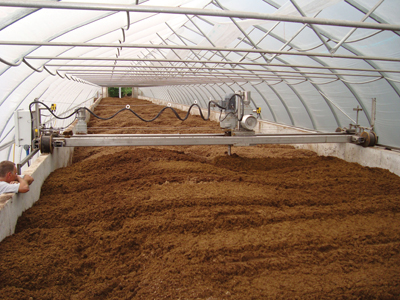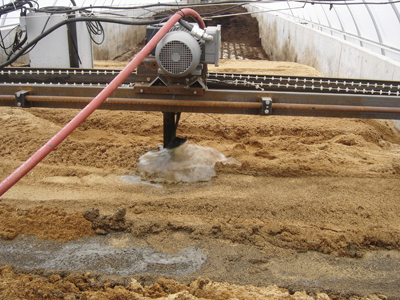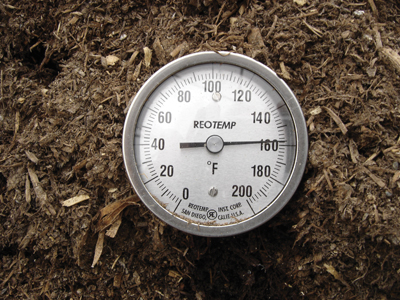
A major challenge in manure management is often the sheer volume and health risks posed by raw manure, and the need to safely dispose of this resource as it accumulates.
A major challenge in manure management is often the sheer volume and health risks posed by raw manure, and the need to safely dispose of this resource as it accumulates.
 |
| By heating the air above raw manure, including liquid manure, Transform Compost Systems is developing technology to evaporate the liquid and leave high value, pathogen-free compost behind. Submitted photos |
Excessive buildup of phosphorus-based nutrients in farmland where too much manure is applied over time is also a problem in some areas.
Imagine what a stress relief it would be if the water content could be removed from hog or dairy manure, for example, and the remaining solids were converted to pathogen-free compost? Compost represents a valuable commodity to such industry sectors as landscapers, nurseries, and garden centers, and it is also a valuable commodity on the farm. Compost can play an important role in revitalizing farmland, according to Dr. John Paul, a PhD in soil microbiology and biochemistry who also worked with Agriculture and Agri-Food Canada for seven years. Canada has lost 30 to 50 percent of the organic matter in its soils already, he says, and this percentage is higher in other parts of the world. Applying compost is a good way to revitalize soil.
The concept of composting has been around for a long time, typically on a smaller scale with individuals composting organic material in their backyards. Given the trend toward more intensive agriculture operations, Dr. Paul’s company, Transform Compost Systems, sensed a trend in agriculture back in 1998 where there would be a strong need to economically recycle nutrients generated from farms in many parts of the world.
“Many farms are net importers of nutrients like feed and other commodities,” says Dr. Paul.
 |
|
| Liquid manure is added to the composting material as it mixes in a process that Transform Compost Systems has developed to evaporate the water from the raw liquid manure and leave a solid compost byproduct behind. |
|
 |
|
| The higher the temperature in the compost pile, the higher the evaporation potential, according to B.C.-based Transform Compost Systems. |
He describes his Abbotsford, B.C.-based company as a provider of design for composting systems, operator training courses for compost facilities, and retailer of composting equipment. The company hasn’t limited its horizons. Its list of projects includes installations throughout North America.
Transform Compost Systems also provided the design, construction manuals, and equipment for a 200 ton per day organic waste composting facility in Qingdao, China, and the design and equipment for a biosolids and chicken manure composting facility in Australia.
Of particular note, the company was involved in the safe composting of diseased chickens in B.C. during the avian flu outbreak in 2004. The company managed the composting of 1.3 million chickens at a central B.C. location, and implemented safe and cost-effective protocols for on-farm composting of poultry litter for 20 different farms.
Because compost can be generated from all organic material, the company caters to both agricultural and non-agricultural clients.
Transform Compost Systems is working on a project using the heat energy that can be generated in the composting process to evaporate the water from liquid manure typically destined for storage lagoons, leaving behind a much smaller volume of pathogen-free compost. Dr. Paul has been working to advance this research since 1994. He notes that every ton of manure has over two million BTUs of potential heat available. The company’s system has much wider potential application than just hog or dairy operations. It is already being applied successfully in a chicken manure composting system.
“We are working with some producers in North America to extract heat out of the composting process,” says Dr. Paul. “Not necessarily to process liquid manure and recycle the heat that way, but in one particular case, to heat poultry barns in the winter months.”
Capturing excess heat from composting chicken manure has added benefits over composting liquid hog manure because – in the case of hog manure – all of the generated heat needs to be used to evaporate the water. With poultry manure, there is a lot less liquid, so the generated heat can be used in other ways, like saving on heating costs.
According to Dr. Paul, when the issue of greenhouse gas emissions began to percolate about 1994, this fueled increased interest in anaerobic digestion of organic waste products. As part of the research involving anaerobic digestion of manure, microbiologists were able to calculate how much energy potential was in manure.
“The problem with anaerobic digestion is that we don’t solve any of our problems, which are too much liquid and too many nutrients,” says Dr. Paul. With anaerobic digestion, even though capturing methane is a valuable commodity for use in power generation, there is still the liquid stream that must be economically disposed of in some way.
Faced with these issues, he says researchers like him thought of turning that potential energy in manure to heat energy, using it to evaporate the water and leaving behind a composted, stable volume of solid nutrients, which can then be marketed or used on farmland as organic fertilizer.
Transform Compost Systems has actually designed a system consisting of an aerated channel system, a stainless steel mixing system, a heat recovery and reuse system, and process optimization. The company is in the process of working with a commercial hog producer to put science into practice. It has built a composting installation, which includes a 30-foot-wide by 250-foot-long composting greenhouse to generate external heat. However, the project was sidelined recently by poor hog prices, which forced the producer to sell his hogs. He is now raising hogs on contract, so Transform Compost Systems intends to restart its project this summer and demonstrate its effectiveness in a commercial setting. This research has been funded in part by the Pork Industry Development Fund, the Greenhouse Gas Initiative and the B.C. Agricultural Council.
“The proposed treatment is to take that liquid manure as soon as possible when it is out of the barn,” says Dr. Paul, “and blend it with a solid matrix to create the composting environment so that we can get the heat to evaporate the water.” Grain straw works well as a solid matrix and it is plentiful in areas where intensive livestock operations are abundant, but use of a variety of materials is possible.
By now, it’s obvious that a critical element for the composting process to work as designed is the ability to generate heat above the liquid manure to both evaporate the water and trigger composting of the remaining solids. Unfortunately, heat is in short supply through a lot of the year in colder climates where a lot of hog production takes place.
“The temperature of the air above the composting material is actually the most critical factor in the whole process,” says Dr. Paul. “As you can imagine, if it is minus 40 (Celsius), getting that air to plus 50 (Celsius) right above the compost is going to be the challenge.” In that case, he says the solution could be to store the liquid manure in winter, and operate the composting process on a seasonal basis, which would still result in having to dispose of a lot less waste material and creation of a valuable compost byproduct.
Transform Compost Systems not only designs systems, it also designs and provides the equipment according to the needs of individual clients.
“There are so many options and ways to skin the cat,” says Dr. Paul. “It’s an ongoing, unfolding of expertise and equipment development and we’re fortunate enough to have some very practical farmers in our network who give us very quick and effective feedback on various pieces of equipment, and how they work or don’t work.”
The company believes that in addition to regular turning, aeration is also critical to achieve high quality compost.
“Forced aeration really does keep the pile composting properly,” he says, “because the aerobic bacteria need oxygen, and they will operate orders of magnitude more efficiently than anaerobic bacteria.” Anaerobic bacteria break down organic material to produce methane in anaerobic digesters, which is an oxygen-free environment.
Dr. Paul says over the past decade, recognition of the value of compost has often depended on the agriculture sector and the basic philosophy of the growers themselves. In some cases, it is just more cost-effective to continue to use inorganic or chemical fertilizers, but there are also instances where growers recognize the value of compost beyond its nutrients.
“We sell some product to the organic sector,” says Dr. Paul, “but there are some large, non-organic farmers that really realize the benefits of improving the soil’s organic matter and the potential disease suppression effects of the compost.”
At the same time, many farms continue to need to economically transport nutrients away from the farm. Composting offers that opportunity, while creating an additional income stream with the creation of a value-added product.